A Geoprocessing Tool for the Calculation of Primary Wood Transportation Distance
Abstract
1. Introduction
2. Materials and Methods
2.1. Development of the Geoprocessing Tool
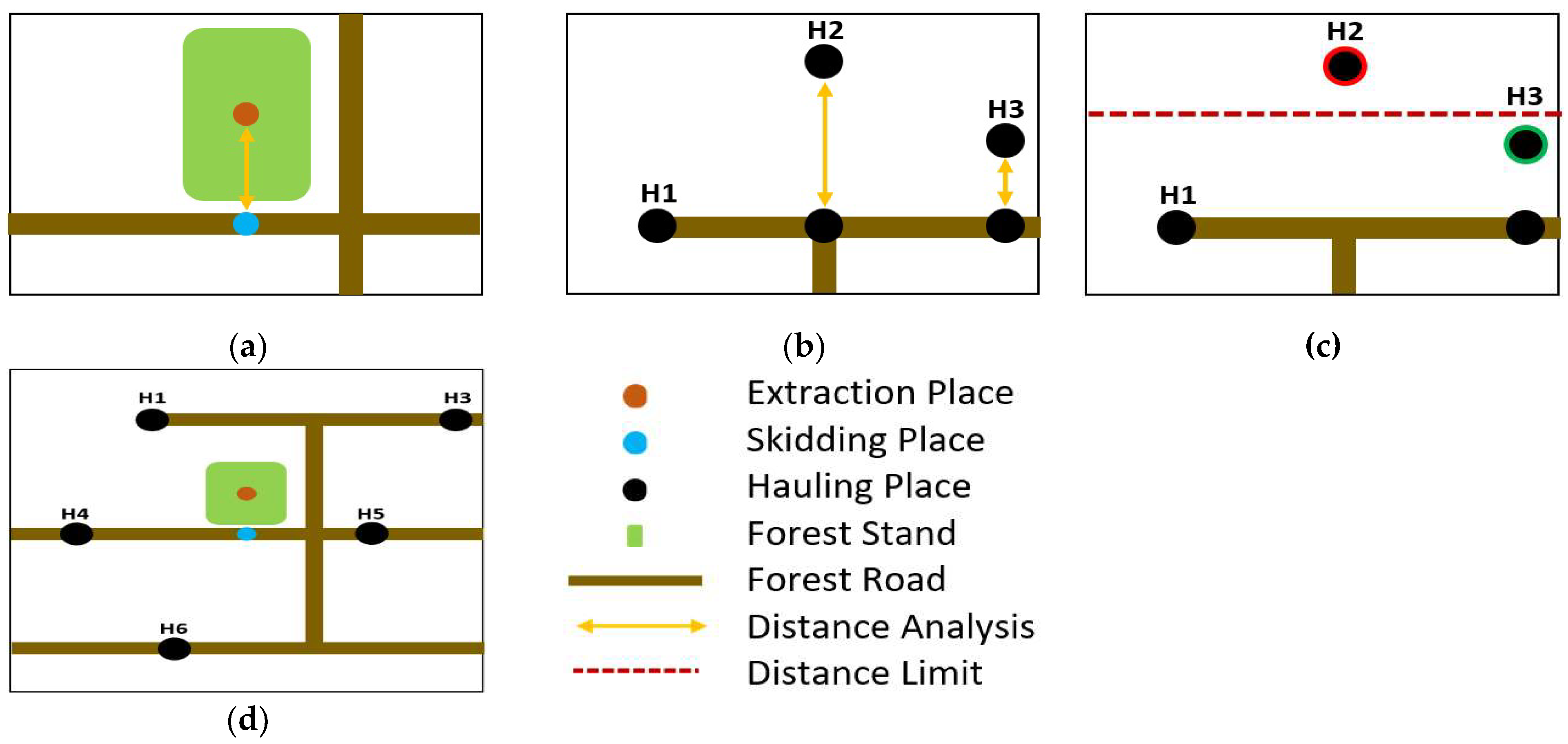


2.2. Applicability Assessment of the Geoprocessing Tool
| Attribute | Specifications |
|---|---|
| GNSS (chipset, channels, antenna) | SiRFstar III GPS L1, 20, Internal |
| Horizontal accuracy (RMS) | DGPS: 1–3 m, Point positioning: 5 m |
| Processor (frequency) | 533 MHz |
| Memory (capacity and type) | 256 MB SDRAM, 2 GB Flash |
| System | Microsoft Windows Mobile 6.5 |
| Attribute | Specifications |
|---|---|
| Processor (frequency, cache, cores) | 2.3/3.9 GHz, 22 MB, 16 |
| Memory (capacity, speed) | 128 GB RAM, 2666 MHz |
| Graphic card (memory, speed, cores) | 16 GB, 1620 MHZ, 48 |
| Internal storage (capacity and type) | 1 TB SSD, 4TB HDD, 4 TB HDD |
| System | Microsoft Windows 10 Pro |
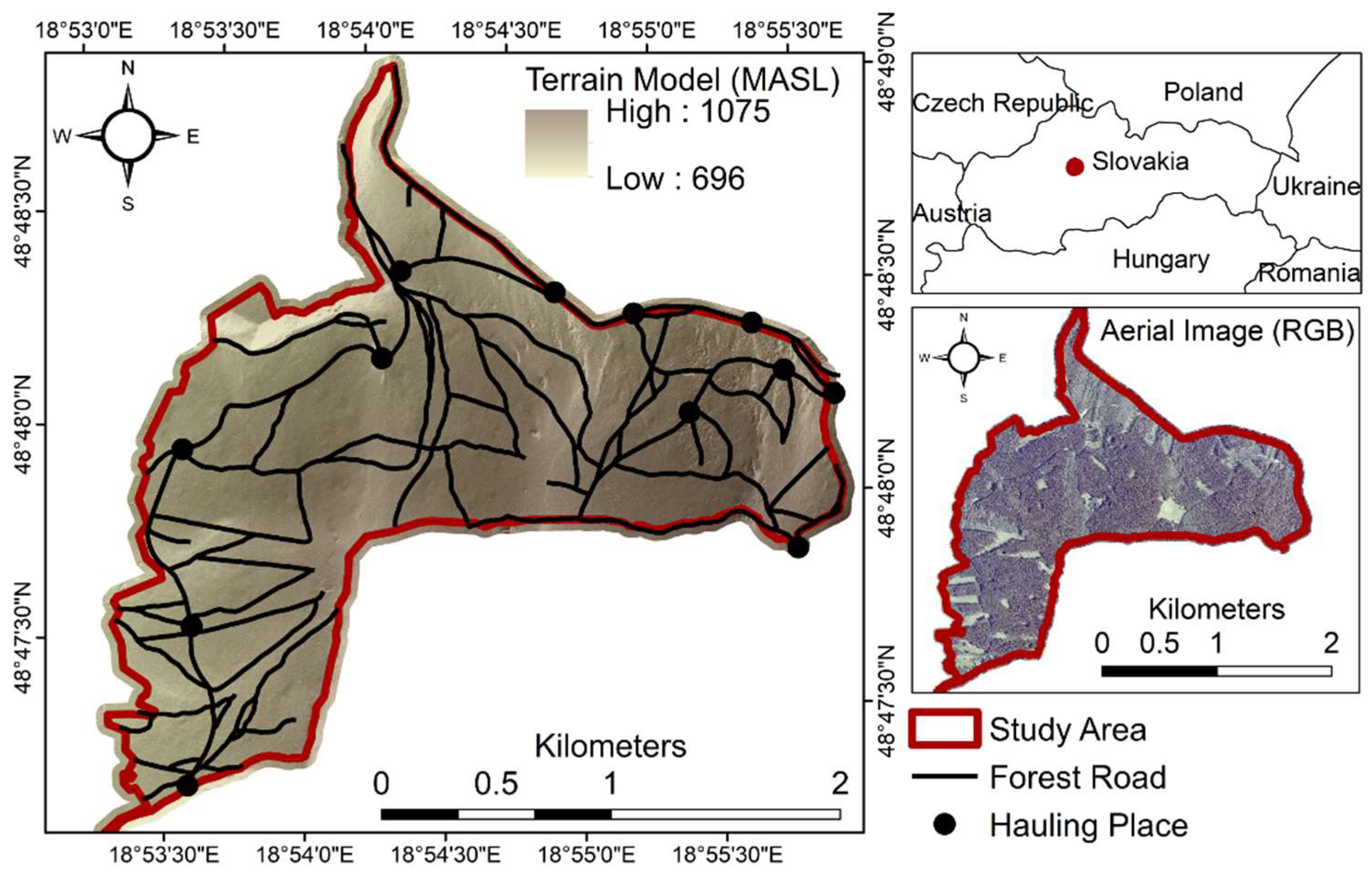
3. Results
3.1. Geoprocessing Tool
3.2. Applicability of the Geoprocessing Tool
4. Discussion
- Knowledge about the distances of all parts of primary wood transportation is essential for sustainable forest management [4]. Here, an appropriate structure of road networks with minimal transportation distances increases the efficiency of forest activities and decreases the negative impact on the environment [5,6,7]. Moreover, transportation distance is a key factor in the management of forest protection against fire and flood events [8,9,10];
- The calculation of primary wood transportation distances based on geospatial methods or tools allows for the use of a comprehensive database and an automated calculation, and the resulting distance is more realistic [26,27]. Nevertheless, there is no powerful single desktop geospatial tool for the calculation of the PSD, SD, and PTD at the 2D and 3D levels [35,36].
4.1. Specificity and Applicability of the Geoprocessing Tool
4.2. Future Improvement of the Geoprocessing Tool
5. Conclusions
- The TraDis tool was developed as an extension for ArcGIS Desktop to calculate the PSD, SD, and PTD at the 2D or 3D levels. The workflow includes four steps: (1) finding the extraction place and skidding place, (2) finding the position of the relevant hauling place on the forest road, (3) finding the nearest hauling place to the skidding place, and (4) measuring the transportation distance;
- The TraDis tool allows for the calculation of transportation distances for various target objects (e.g., forest stands, cells, tree crowns, or buildings). The case study presented herein showed that the calculation of 2D distances for different numbers and types of target objects could take from 0.2 s ha−1 to 81.9 s ha−1, and the 3D calculation increased this time consumption by 63 ±10%. Moreover, the PSD and SD at the 3D level could be 3.6% and 0.9% greater than these distances at the 2D level, respectively;
- The future improvement of the TraDis tool could include (1) the modification of the algorithm to other, even freely available, geospatial environments and (2) the implementation of additional conditions (i.e., slope, category of the road) into the algorithm. These future improvements would make the calculation of transportation distances more available and realistic.
Author Contributions
Funding
Data Availability Statement
Conflicts of Interest
References
- Schiess, P.; Krogstad, F. Forest Harvest and Transportation. In Fishes and Forestry: Worldwide Watershed Interactions and Management; Northcote, T.G., Hartman, G.F., Eds.; Wiley-Blackwell: Hoboken, NJ, USA, 2007; pp. 193–215. [Google Scholar]
- Çağlar, S.; Altunel, A.O. The Effects of Primer Transport Techniques on Raw Wood Materials in Turkey. In Proceedings of the International Forest Products Congress, Trabzon, Turkey, 26–29 September 2018; pp. 818–827. [Google Scholar]
- Koirala, A.; Kizha, A.R.; De Hoop, C.F.; Roth, B.E.; Han, H.-S.; Hiesl, P.; Abbas, D.; Gautam, S.; Baral, S.; Bick, S.; et al. Annotated Bibliography of the Global Literature on the Secondary Transportation of Raw and Comminuted Forest Products (2000–2015). Forests 2018, 9, 415. [Google Scholar] [CrossRef]
- Shadbahr, J.; Bensebaa, F.; Ebadian, M. Impact of forest harvest intensity and transportation distance on biomass delivered costs within sustainable forest management—A case study in southeastern Canada. J. Environ. Manag. 2021, 284, 112073. [Google Scholar] [CrossRef]
- Palander, T.; Borz, S.A.; Kärhä, K. Impacts of Road Infrastructure on the Environmental Efficiency of High Capacity Transportation in Harvesting of Renewable Wood Energy. Energies 2021, 14, 453. [Google Scholar] [CrossRef]
- Borz, S.A.; Crăciun, B.C.; Marcu, M.V.; Iordache, E.; Proto, A.R. Could timber winching operations be cleaner? An evaluation of two options in terms of residual stand damage, soil disturbance and operational efficiency. Eur. J. For. Res. 2023, 1–17. [Google Scholar] [CrossRef]
- Palander, T.; Haavikko, H.; Kortelainen, E.; Kärhä, K. Comparison of Energy Efficiency Indicators of Road Transportation for Modeling Environmental Sustainability in “Green” Circular Industry. Sustainability 2020, 12, 2740. [Google Scholar] [CrossRef]
- Mohammadi, Z.; Lohmander, P.; Kašpar, J.; Marušák, R. The effect of road networks on the forest wildfires size. In Proceedings of the EGU General Assembly 2021, Online, 19–30 April 2021. [Google Scholar]
- Marche, J.; Lettenmaier, D. Effects of Forest Roads on Flood Flows in the Deschutes River, Washington. Earth Surf. Process. Landf. 2001, 26, 115–134. [Google Scholar] [CrossRef]
- Ruiz-Villanueva, V.; Bodoque, J.; Díez-Herrero, A.; Bladé, E. Large Wood Transport as Significant Influence on Flood Risk in a Mountain Village. Nat. Hazards 2014, 74, 967–987. [Google Scholar] [CrossRef]
- Enache, A.; Pentek, T.; Ciobanu, V.; Stampfer, K. GIS based methods for computing the mean extraction distance and its correction factors in Romanian mountain forests. Sumar. List. 2015, 139, 35–46. [Google Scholar]
- Matthews, D.M. Cost Control in the Logging Industry; McGraw-Hill Book Company Inc.: New York City, NY, USA, 1942; pp. 1–374. [Google Scholar]
- Segebaden, G. Studies of cross-country transport distances and road net extension. Stud. For. Suec. 1964, 18, 1–70. [Google Scholar]
- Klč, P.; Žáček, J.; Sotorník, M. Accessibility of the forests in the Czech Republic through forest transportation network. Lesn. Časopis—For. J. 2006, 52, 297–310. [Google Scholar]
- Tománek, J.; Volný, C. Examination of current access to forest and projected finishing of main logging road network in selected area of Beskids. Lesn. Časopis—For. J. 2009, 55, 409–417. [Google Scholar]
- Lotfalian, M.; Zadeh, E.; Hosseini, S. Calculating the correction factor of skidding distance based on forest road network. J. For. Sci. 2011, 57, 467–471. [Google Scholar] [CrossRef]
- Simões, D.; Cavalcante, F.S.; Lima, R.C.A.; Rocha, Q.S.; Pereira, G.; Miyajima, R.H. Optimal Forest Road Density as Decision-Making Factor in Wood Extraction. Forests 2022, 13, 1703. [Google Scholar] [CrossRef]
- Zhixian, Z.; Zhili, F. The Method of Calculating Average Skidding Distance. J. For. Res. 1997, 8, 47–49. [Google Scholar] [CrossRef]
- Backmund, F. Kennzahlen für den Grad der Erschließung von Forstbetrieben durch autofahrbare Wege. Forstwiss. Cent. 1966, 85, 342–354. [Google Scholar] [CrossRef]
- Dietz, P.; Knigge, W.; Löffler, H. Walderschlieβung; Verlag Paul Parey: Hamburg, Germany, 1984; p. 426. [Google Scholar]
- Sessions, J. Harvesting Operations in the Tropics; Springer: Berlin/Heidelberg, Germany, 2007; p. 170. [Google Scholar]
- Kweon, H. Comparisons of Estimated Circuity Factor of Forest Roads with Different Vertical Heights in Mountainous Areas, Republic of Korea. Forests 2019, 10, 1147. [Google Scholar] [CrossRef]
- Krč, J.; Košir, B. Predicting wood skidding direction on steep terrain by DEM and forest road network extension. Croat. J. For. Eng. 2008, 29, 177–188. [Google Scholar]
- Folegatti, B. The Application of Precision Forestry Technologies in Logging Operations. Master’s Thesis, Department of Forestry and Wildlife Sciences, Auburn University, Auburn, AL, USA, 2010; p. 138. [Google Scholar]
- Kulak, D.; Stanczykiewicz, A.; Szewczyk, G. Productivity and time consumption of timber extraction with a grapple skidder in selected pine stands. Croat. J. For. Eng. 2017, 38, 55–63. [Google Scholar]
- Abdi, E.; Majnounian, B.; Darvishsefat, A.; Mashayekhi, Z.; Sessions, J. A GIS-MCE based model for forest road planning. J. For. Sci. 2009, 55, 171–176. [Google Scholar] [CrossRef]
- Picchio, R.; Latterini, F.; Mederski, P.S.; Venanzi, R.; Karaszewski, Z.; Bembenek, M.; Croce, M. Comparing Accuracy of Three Methods Based on the GIS Environment for Determining Winching Areas. Electronics 2019, 8, 53. [Google Scholar] [CrossRef]
- Pentek, T.; Pičman, D.; Potočnik, I.; Dvorščak, P.; Nevečerel, H. Analysis of an existing forest road network. Croat. J. For. Eng. 2005, 26, 39–50. [Google Scholar]
- Petkovic, V.; Marčeta, D.; Ljubojevic, D.; Kuburić, J. Determination of average skidding distance using GIS. Nova Meh. Sumar. 2017, 38, 33–42. [Google Scholar]
- Sačkov, I.; Smreček, R.; Tucek, J. Forest transportation survey based on airborne laser scanning data and GIS analyses. GIScience Remote Sens. 2014, 51, 83–98. [Google Scholar] [CrossRef]
- Duka, A.; Grigolato, S.; Papa, I.; Pentek, T.; Poršinsky, T. Assessment of timber extraction distance and skid road network in steep karst terrain. Iforest—Biogeosciences For. 2017, 10, 886–894. [Google Scholar] [CrossRef]
- Ljubojevic, D.; Danilović, M.; Marčeta, D.; Petkovic, V. Winching Distance in Function of the Optimization of Skid Network. S.E. Eur. For. 2018, 9, 97–106. [Google Scholar] [CrossRef]
- Knuth, D.E. A generalization of Dijkstra’s algorithm. Inf. Process. Lett. 1977, 6, 1–5. [Google Scholar] [CrossRef]
- Toms, S.; O’Beirne, D. ArcPy and ArcGIS: Automating ArcGIS for Desktop and ArcGIS Online with Python, 2nd ed.; Packt Publishing: Birmingham, UK, 2017; p. 272. [Google Scholar]
- Heinimann, H.R. A computer model to differentiate skidder and cable-yarder based road network concepts on steep slopes. J. For. Res. 1998, 3, 1–9. [Google Scholar] [CrossRef]
- Amhuri, J.; Norizah, K.; Mohd Hasmadi, I.; Azfanizam, A.S. Bees algorithm for Forest transportation planning optimization in Malaysia. For. Sci. Technol. 2021, 17, 88–99. [Google Scholar]
- Sales, A.; Gonzáles, D.G.E.; Martins, T.G.V.; Silva, G.C.C.; Spletozer, A.G.; Telles, L.A.d.A.; Siviero, M.A.; Lorenzon, A.S. Optimization of Skid Trails and Log Yards on the Amazon Forest. Forests 2019, 10, 252. [Google Scholar] [CrossRef]
- Parsakhoo, A.; Mohammad, J. Determining an optimal path for forest road construction using Dijkstra’s algorithm. J. For. Sci. 2016, 62, 264–268. [Google Scholar] [CrossRef]
- Ricards, A. Forest Road Location Modelling with Dijkstra’s Shortest Path and ArcGIS. Ph.D. Thesis, Faculty of Natural Resources Management Lakehead University, Thunder Bay, ON, Canada, 2019; p. 36. [Google Scholar]
- Kanzaki, K.; Ohasi, K.; Deki, T.; Miyake, T. On capillary path systems in steep mountain areas. Int. J. For. Eng. 1990, 2, 17–21. [Google Scholar] [CrossRef]
- Abegg, B. Estimation of the optimal forest road density in skidder terrain. Mitteilungen 1978, 54, 101–213. [Google Scholar]
- QGIS Geographic Information System. Available online: http://qgis.osgeo.org (accessed on 31 January 2023).
- GRASS Geographic Information System. Available online: http://grass.osgeo.org (accessed on 31 January 2023).

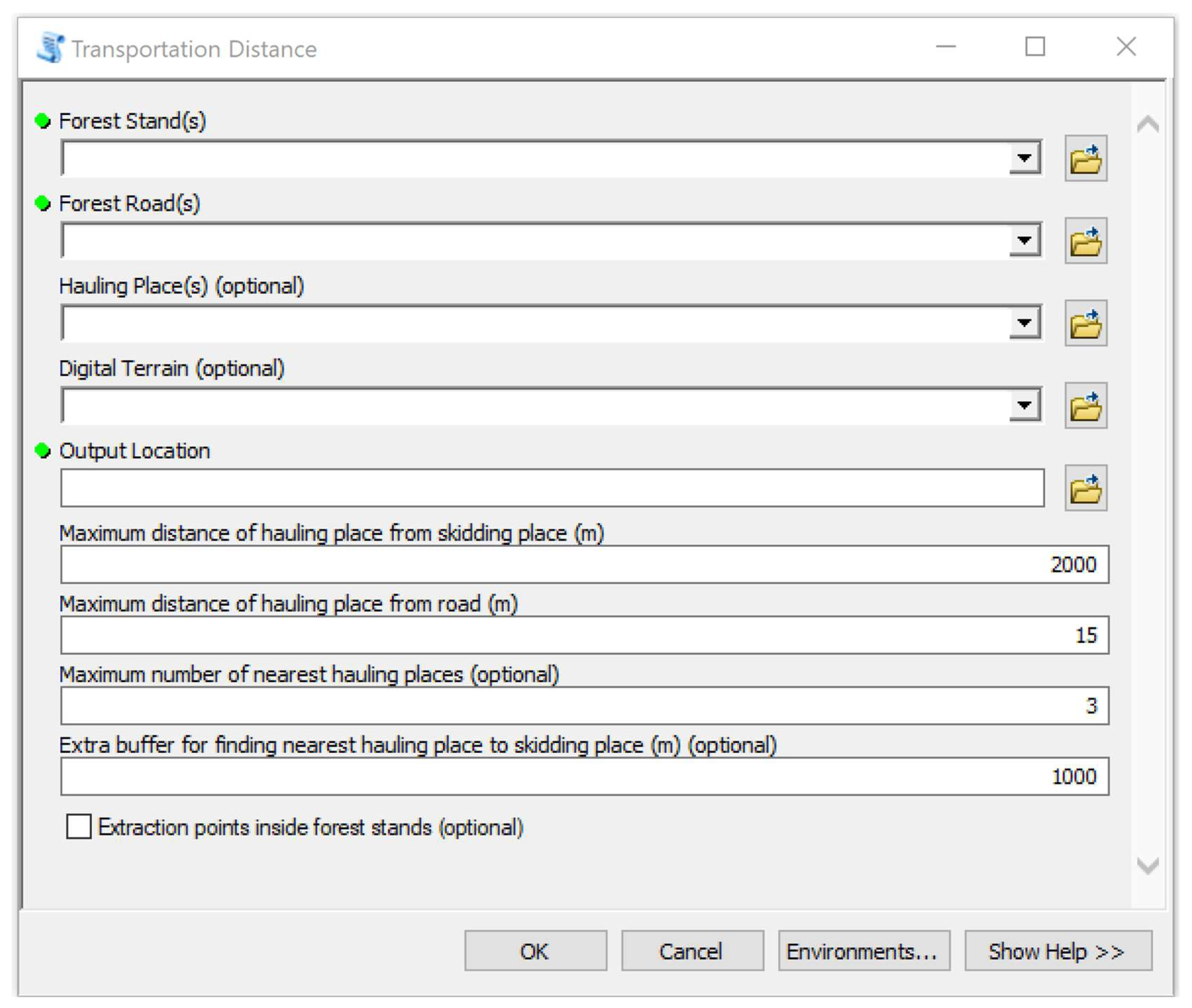
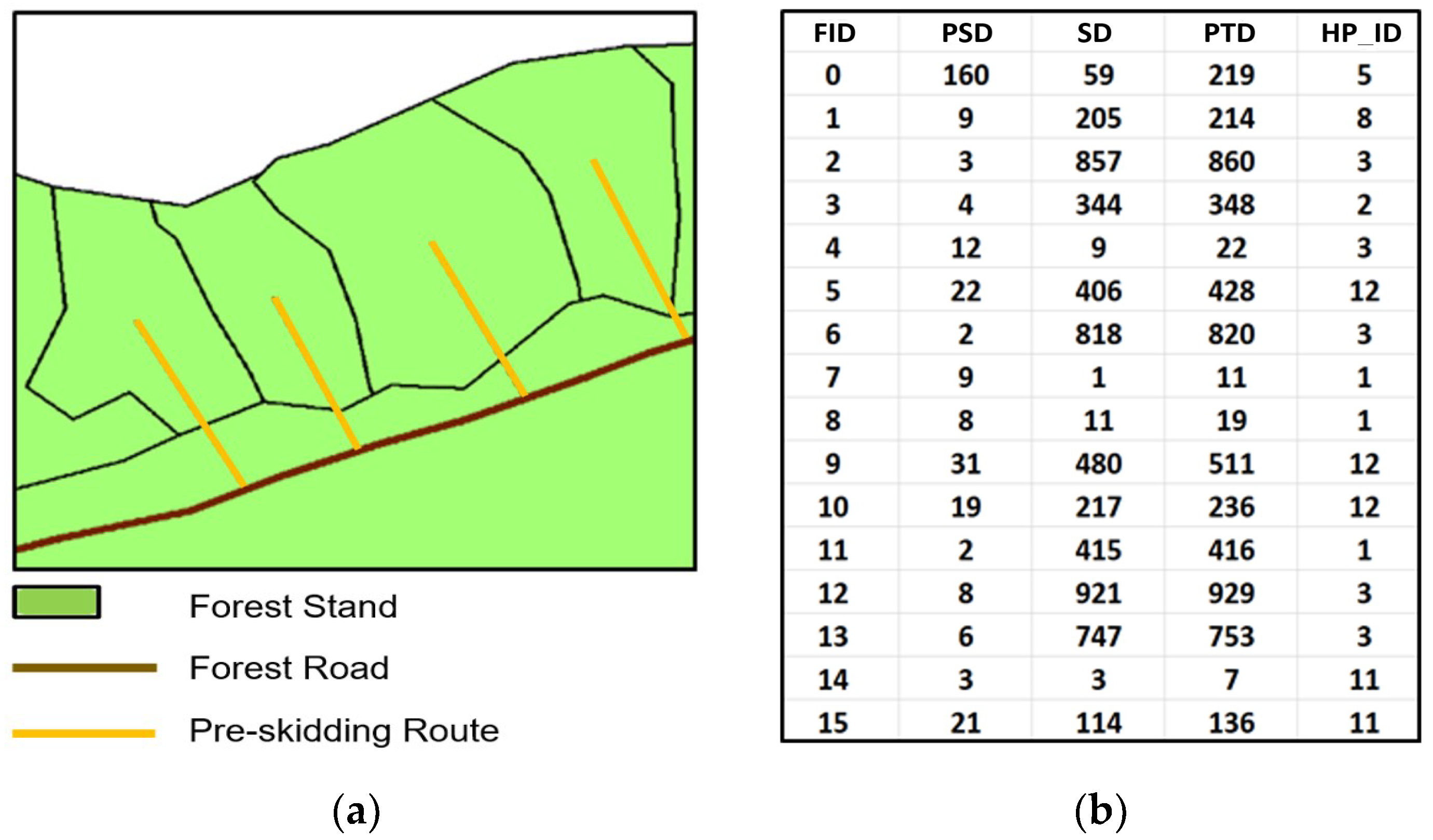
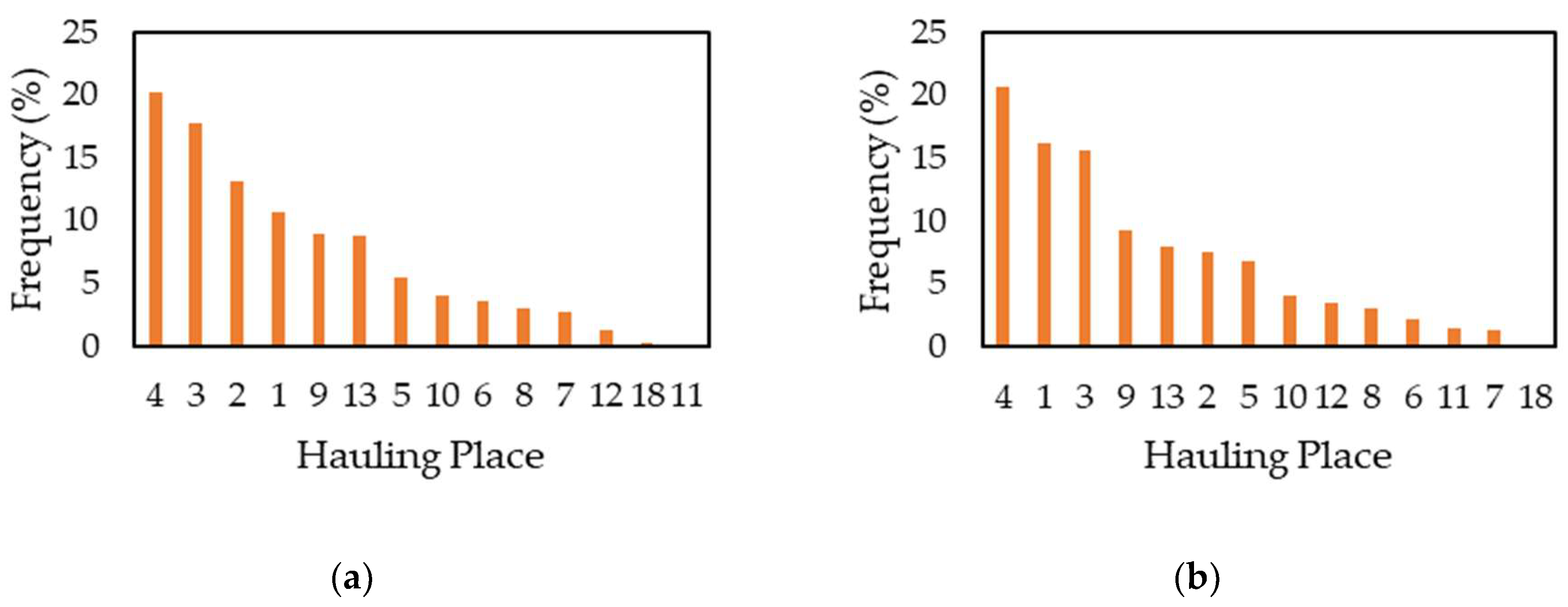
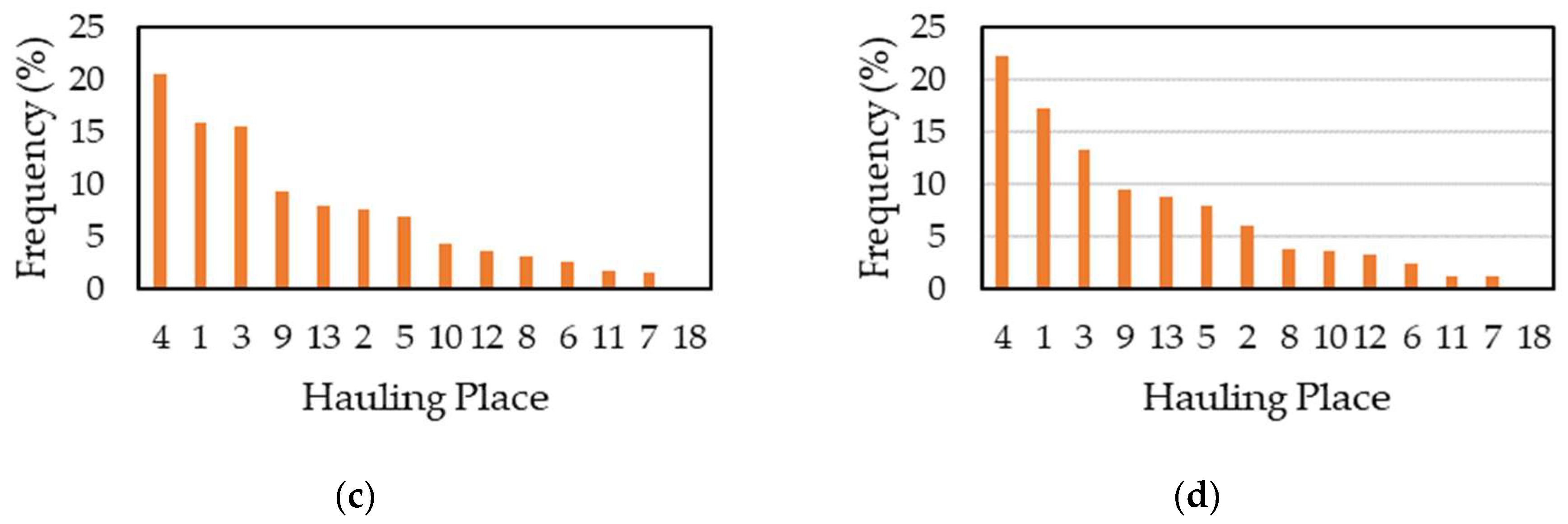

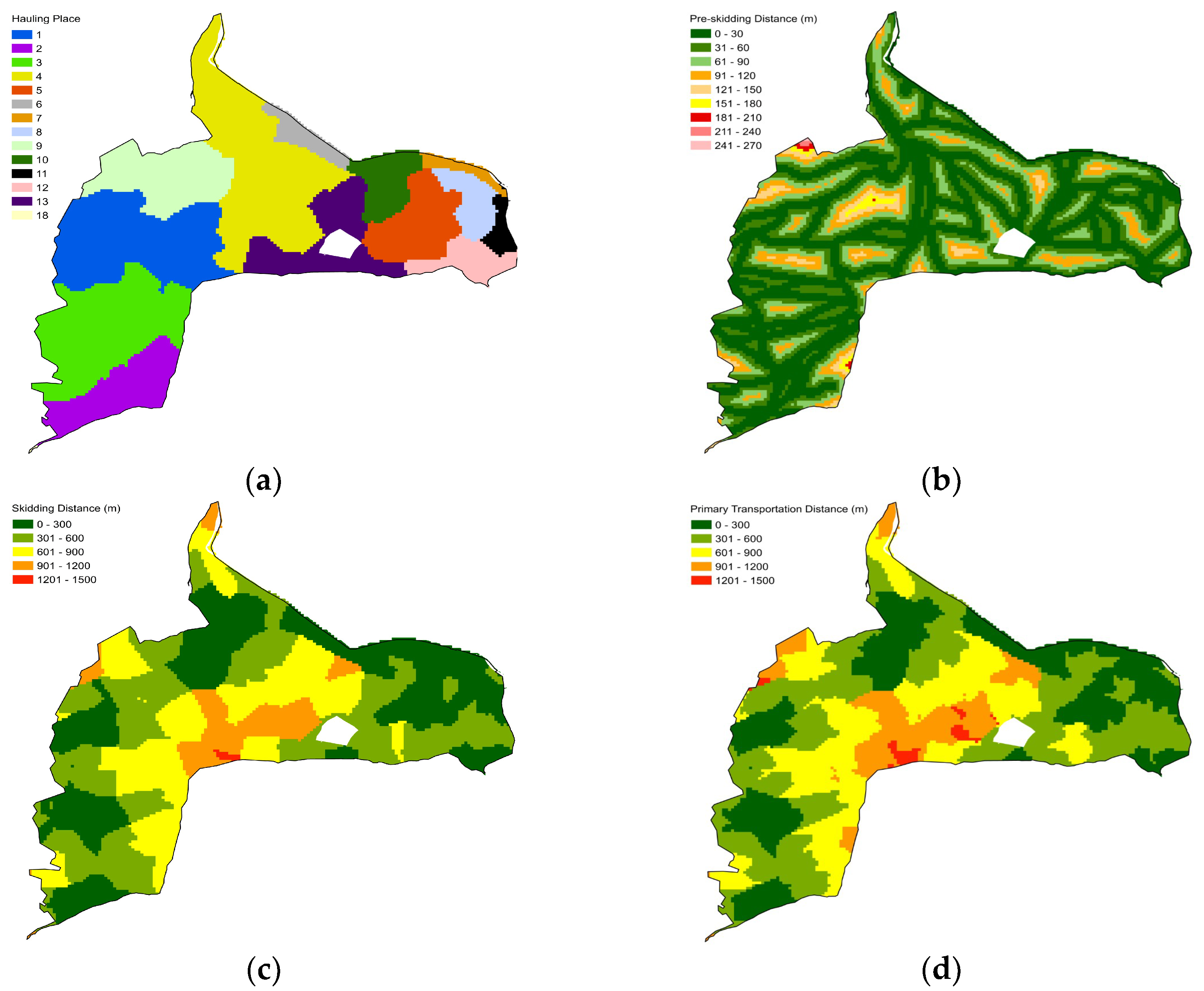
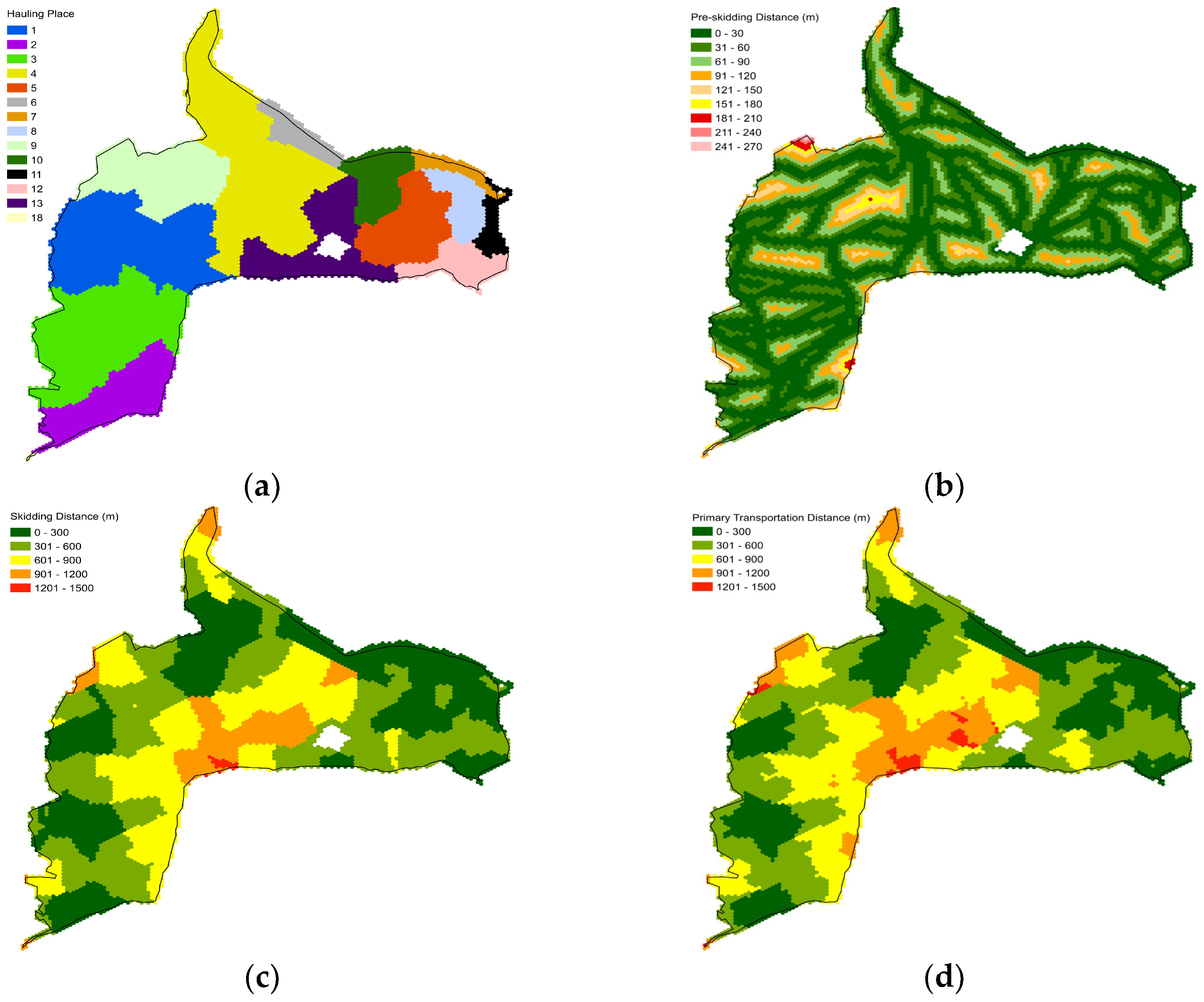
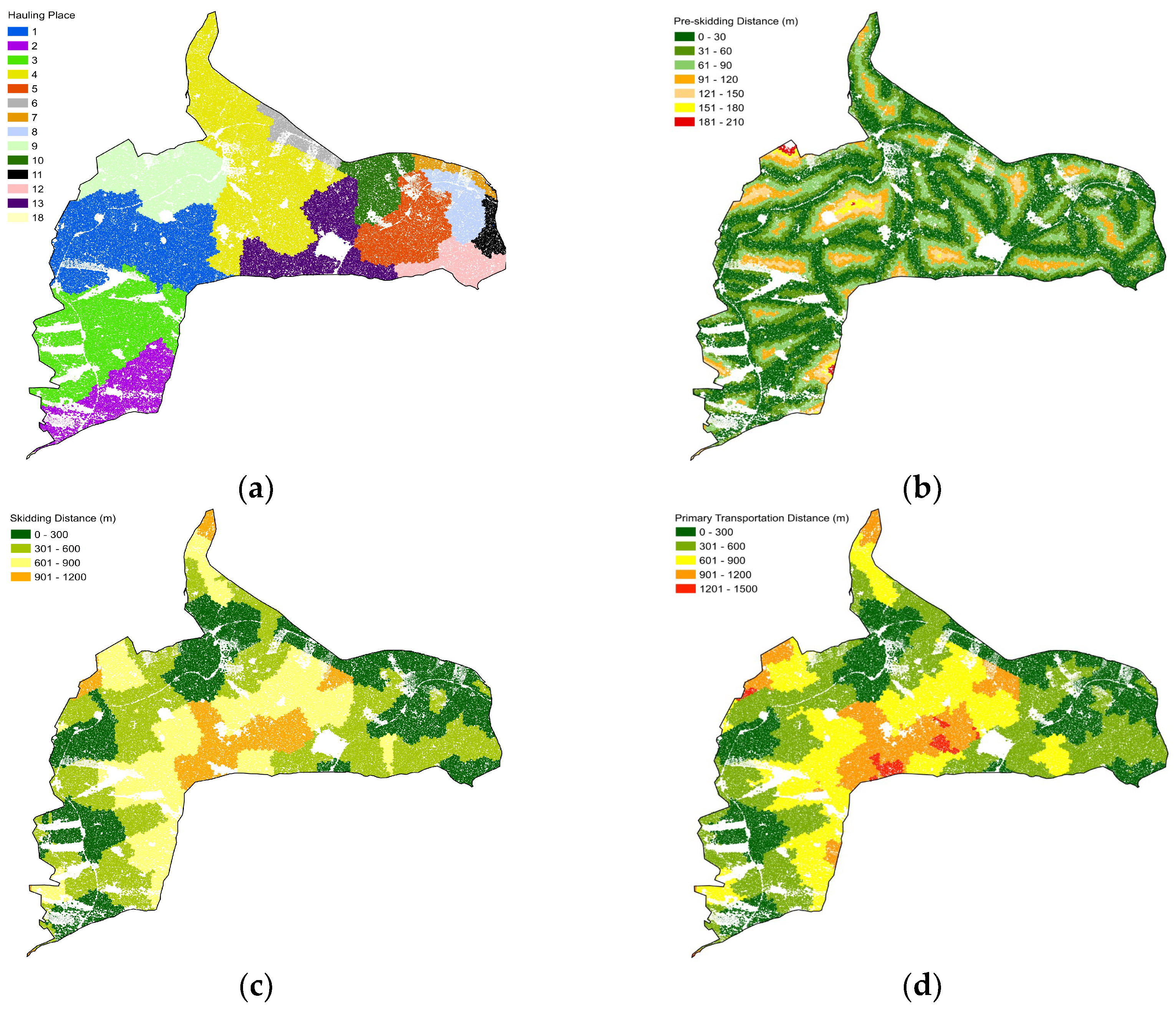
| Dimension of Distance | Forests | Squares | Hexagons | Crowns |
|---|---|---|---|---|
| Two-dimensional (s ha−1) | 0.16 | 3.18 | 2.01 | 81.86 |
| Three-dimensional (s ha−1) | 0.24 | 5.33 | 3.36 | 139.25 |
| Category of Distance | Forests | Squares | Hexagons | Crowns |
|---|---|---|---|---|
| Pre-skidding (m) | 42.8 ± 37.8 | 44.5 ± 36.0 | 44.3 ± 36.2 | 46.2 ± 35.5 |
| Skidding (m) | 429.6 ± 274.1 | 480.3 ± 281.9 | 477.4 ± 283.3 | 479.3 ± 284.4 |
| Primary transportation (m) | 472.3 ± 283.9 | 524.9 ± 290.2 | 521.7 ± 291.8 | 525.5 ± 291.5 |
| Category of Distance | Forests | Squares | Hexagons | Crowns |
| Pre-skidding (m) | 44.4 ± 39.5 | 46.0 ± 37.4 | 45.8 ± 37.7 | 47.8 ± 36.9 |
| Skidding (m) | 433.4 ± 277.3 | 484.7 ± 285.5 | 481.9 ± 286.9 | 483.7 ± 288.0 |
| Primary transportation (m) | 477.7 ± 287.3 | 530.7 ± 293.8 | 527.7 ± 295.5 | 531.5 ± 295.1 |
Disclaimer/Publisher’s Note: The statements, opinions and data contained in all publications are solely those of the individual author(s) and contributor(s) and not of MDPI and/or the editor(s). MDPI and/or the editor(s) disclaim responsibility for any injury to people or property resulting from any ideas, methods, instructions or products referred to in the content. |
© 2023 by the authors. Licensee MDPI, Basel, Switzerland. This article is an open access article distributed under the terms and conditions of the Creative Commons Attribution (CC BY) license (https://creativecommons.org/licenses/by/4.0/).
Share and Cite
Sačkov, I.; Barka, I. A Geoprocessing Tool for the Calculation of Primary Wood Transportation Distance. Forests 2023, 14, 907. https://doi.org/10.3390/f14050907
Sačkov I, Barka I. A Geoprocessing Tool for the Calculation of Primary Wood Transportation Distance. Forests. 2023; 14(5):907. https://doi.org/10.3390/f14050907
Chicago/Turabian StyleSačkov, Ivan, and Ivan Barka. 2023. "A Geoprocessing Tool for the Calculation of Primary Wood Transportation Distance" Forests 14, no. 5: 907. https://doi.org/10.3390/f14050907
APA StyleSačkov, I., & Barka, I. (2023). A Geoprocessing Tool for the Calculation of Primary Wood Transportation Distance. Forests, 14(5), 907. https://doi.org/10.3390/f14050907











